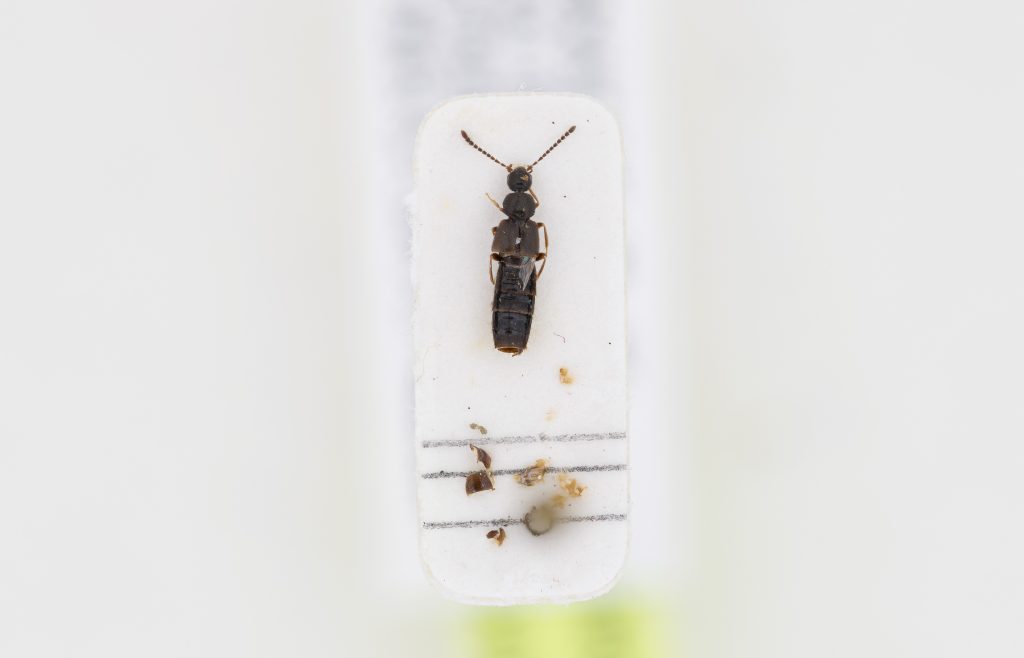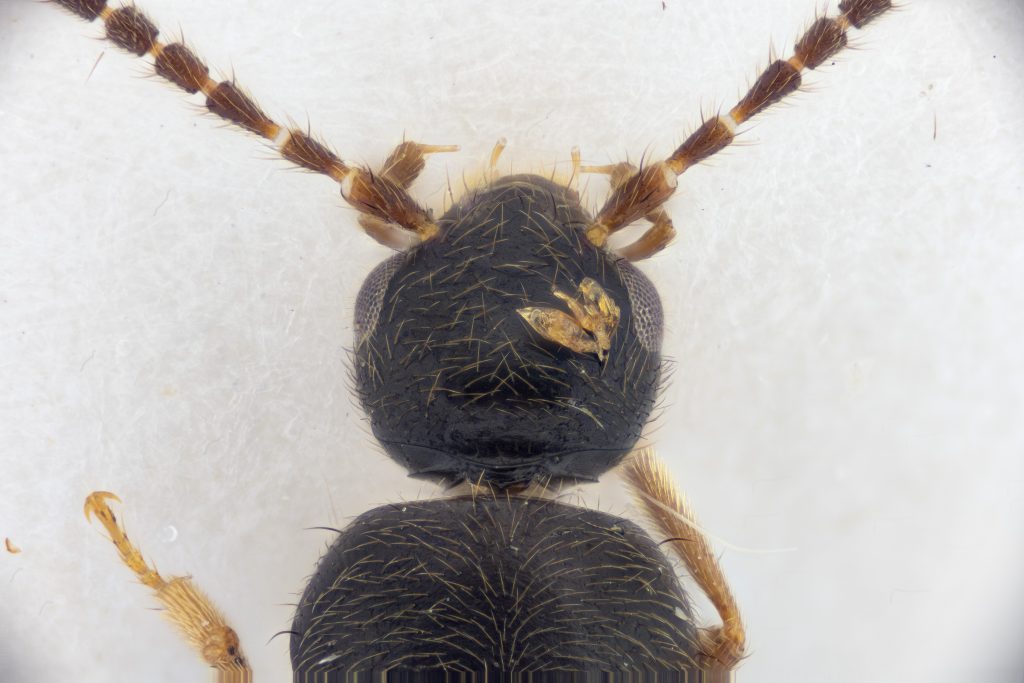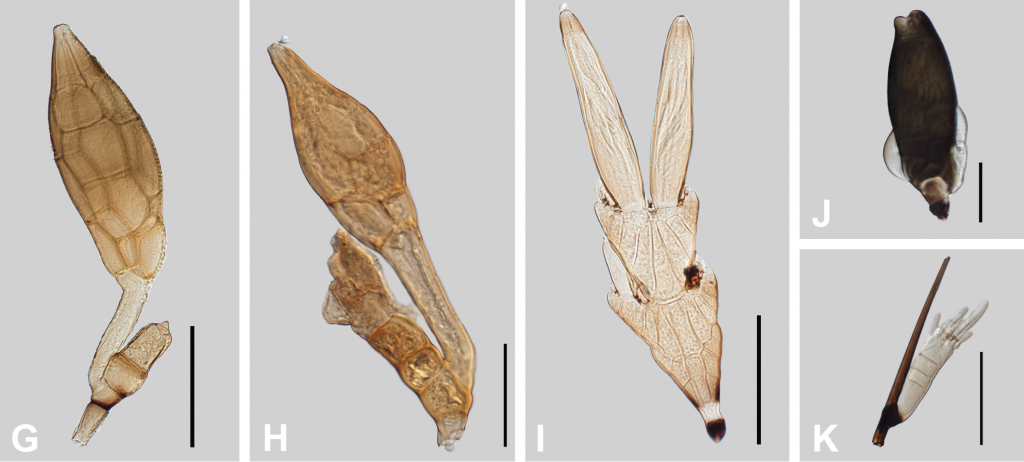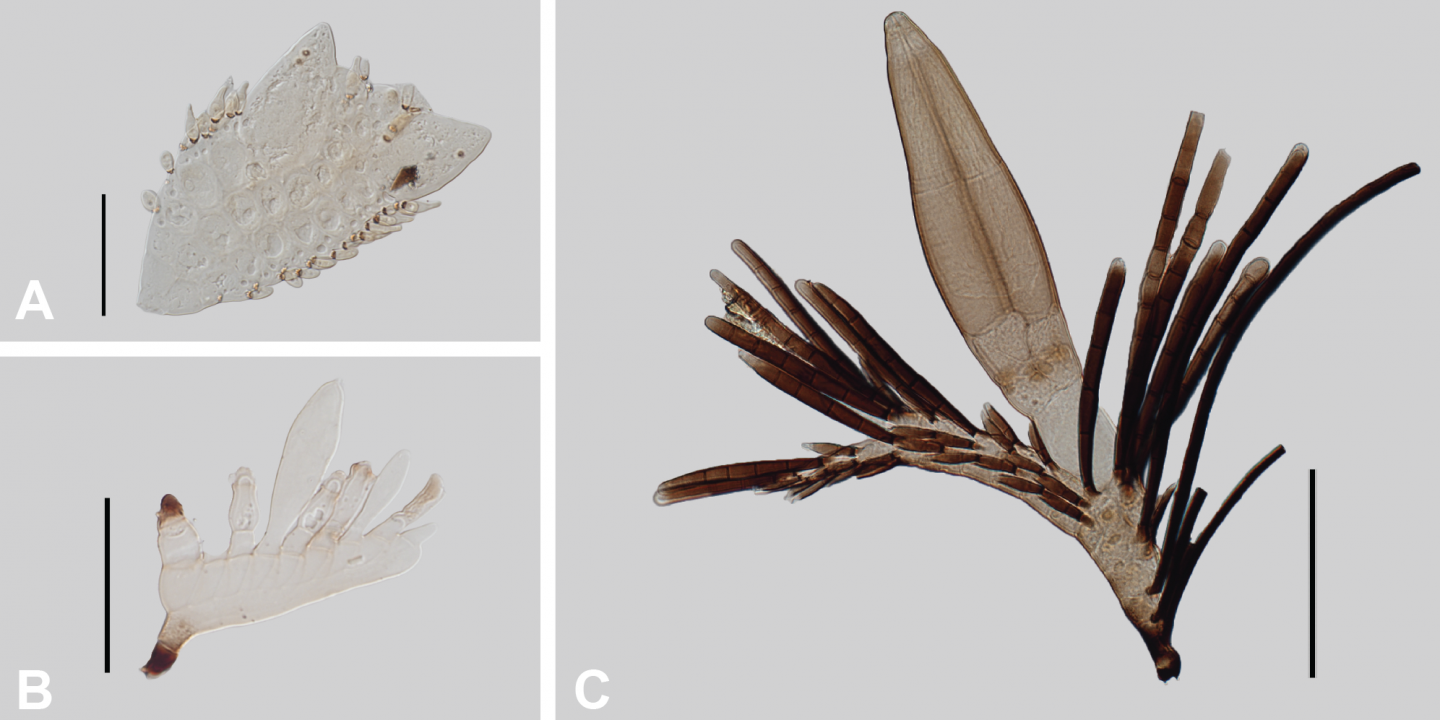Let me introduce you to the Group of the Month for March: A fungus!

At this point you are probably thinking to yourself: “Wait a minute, that’s not a fungus. That’s clearly just a beetle…” And for the most part, you’d be right! Let’s zoom in a bit further:

Now you are probably thinking: “Hmm.. That didn’t change much.. That’s still just a… Wait a minute! What’s that on it’s head?” And with a little bit of additional zooming, we finally arrive at our stowaway:

Indeed, there is a fungus attached to the head of the Atheta graminicola!
More specifically, the fungus in question is a representative of an order of tiny fungi called Laboulbeniales, which is the Group of the Month for March. If you have been following our advent calendar, you’ll know from Door 13: Discovering hidden microscopic diversity in Norway that the Laboulbeniales are a group of obligate ectoparasitic fungi that grow on many different invertebrate groups. Among these groups more than 80% of the known potential host species are beetles. Thus, the Labouls are commonly and aptly referred to as “Beetle hangers”. This close association between the fungi and their invertebrate hosts make knowledge and expertise regarding both the fungi and their hosts a necessity for effectively studying the group. In combination with the microscopic size of the Labouls, this has led to the group being widely understudied in most of the world despite the large size of the group. Currently more than 2200 species have been described in 142 genera, although these might represent only a small fraction of the actual diversity within the group (Haelewaters et al., 2021). Below are examples of some representatives of the different genera that are currently being explored in Norway. As you can see, the fungi can vary extensively in shape and size. This variation emphasizes the marvel that is the world of microscopic diversity, all hidden to the naked eye.

D. Monoicomyces homalotae from Atheta sp., E. Monoicomyces fragilis from Ocalea picata, F. Stichomyces conosomatis from Sepedophilus testaceus. Scale bars: D = 50 um; E–F = 100 um.
After seeing some examples of Labouls, you might be returning to your train of thought, thinking: “Now hang on a minute! These fungi do not look like fungi at all! Fungi create mushroom fruiting bodies, or they create vast networks of mycelium. And if they don’t its most often because they are single celled.” And you would be correct. The members of the Laboulbeniales are not very fungi-like at all!
Instead of possessing the usual fungi characteristics, Labouls have evolved their own way of life. Unlike most fungi, the group never form any hyphae. Instead, they form the microscopic thalli that you can see in the figures, which arise from a two-celled meiospore which has been directly transferred from one host to the other by physical contact between the two. This is why the Labouls are referred to as obligate ectoparasites: they spend their entire life cycle on their arthropod host. The total size of the mature thalli can range from only a few cells, and up to many hundreds of cells.
The non-fungi-like characteristics of the group long made for intense arguing amongst early researchers about what the fungi actually were. Some researcher proposed that the group might be direct or indirect descendants of Floridean red algae. Others examined the tripartite relationships between bats, bat flies and Labouls and suggested the latter to be parasitic worms. However, following the seminal and extraordinary efforts of Roland Thaxter some 150 years ago, the group has since been firmly regarded as ascomycete fungi.
As a result of their unique morphology and life cycles, there are many aspects of the ecology and physiology of the group that are still largely unknown. For instance, as Labouls do not form hyphae, how do they take up nutrients from the host? The answer lies within the darkened foot cell at the base of most thalli, which is also responsible for attachment to the host integument. However, differing hypotheses exist on how nutrients are extracted through the foot. Some argue that the nutrients are extracted directly from pore canals in the cuticle of the host and through the foot cell, whereas others point out that so-called haustoria might be how nutrients are taken up. Haustoria are structures that are continuous with the cytoplasm of the foot cell, and that penetrate the cuticle of the host. For some subgroups, haustoria have been observed, whereas in others they seem to be lacking.
Another interesting aspect of the thalli is their potential for host-, position- and sex specificity. Some species of Laboulbeniales have a wide range of potential host species, both within genera and also among different genera of hosts. Others are specific to only one host species. Similarly, some hosts can be host to multiple different species of Labouls, with some even co-existing on the same host specimen. To further complicate things, morphologically similar thalli might represent multiple genetically diverging species depending on their position on the host. Some thalli only grow on leg parts, some only on the tip of the abdomen, and some even prefer either the left or the right side of the elytra. Similarly, there are some species that only grow on one sex of the host species, often depending on how the two sexes interact physically with each other.

G. Haplomyces texanus from Bledius vilis, H. Cantharomyces orientalis from Carpelimus bilineatus, I. Peyritschiella principes from Bisnius cephalotes, J. Diphymyces niger from Ptomaphagus subvillosus, K. Juvenile Symplectromyces vulgaris on setae from Quedius cruentatus. Scale bars: H, K = 50 um; G, I = 100 um; J = 25 um.
Despite recent advances in molecular methods over the past few decades, the inability to culture Laboulbeniales have made extracting and amplifying DNA from the small thalli difficult. This has delayed efforts to clarify lower level classifications within the group. However, newer methods are currently showing more success, and DNA repositories are currently being assembled in order to tackle the issues. As such, over the next few years, many of the mysteries of these unusual fungi are expected to be resolved, including specificity and species complexes.
Advancements in technology does not, however, make up for the lack of taxonomic expertise within the group. In most countries the Laboulbeniales have hardly been explored at all, and all of the common shortfalls in biodiversity knowledge are relevant for the group. Recently, a new shortfall was introduced based of off the group, namely the Thaxterian shortfall, in order to express the lack of taxonomic expertise and active work being done on understudied group (Cazabonne et al., 2025). In Norway, that is where the iNoLa-project steps onto the scene. As mentioned in the advent calendar, the goal of the project has been to discover as many new species for Norway as possible, with a special focus on the Staphylinoidea group of host species. As the project is approaching it’s final stages, over 800 infected beetle specimens are still being examined by our colleagues in Belgium, in order to ensure confirmed identifications of the Laboul species. Prior to the project only 16 species were recorded in Norway. As this stage of the project closes out, this number will have increased to around 75 species. In addition, many arthropod species of groups outside our focus have been found to be infected, serving as inspiration for continuing this fruitful project in the future.
Featured image caption: A. Rickia hyperborea from Micralymma marinum, B. Dimorphomyces phloeoporae from Phloeopora testacea, C. Rhachomyces furcatus from Othius myrmecophilus. Scale bars: A–B = 50 um; C = 100 um.
Further reading:
Blackwell M, Haelewaters D, Pfister DH. 2020. Laboulbeniomycetes: evolution, natural history, and Thaxter’s final word. Mycologia. 112(6):1048–1059 https://doi.org/10.1080/00275514.2020.1718442
Cazabonne J, Martin TE, Matthews TJ, Quandt A, Wayman JP, Haelewaters D. 2025. Knowledge gaps explored for Laboulbeniomycetes, a clade of understudied microfungi, including a new shortfall related to a lack of taxonomic expertise. Authorea. 10.22541/au.173956895.54632274/v2
Haelewaters D, Blackwell M, Pfister DH. 2021. Laboulbeniomycetes: Intimate Fungal Associates of Arthropods. Annual review of entomology. 66:257–276. https://doi.org/10.1146/annurev-ento-013020-013553
Haelewaters D, Pfliegler WP, Gorczak M, Pfister DH. 2019. Birth of an order: comprehensive molecular phylogenetic study reveals that Herpomyces (Fungi, Laboulbeniomycetes) is not part of Laboulbeniales. Mol. Phylogenet. Evol. 133:286–301. https://doi.org/10.1016/j.ympev.2019.01.007
Santamaria S, Pedersen J. 2021. Laboulbeniomycetes (Fungi, Ascomycota) of Denmark. European Journal of Taxonomy. 781(1):1–425. https://doi.org/10.5852/ejt.2021.781.1583
![]()
